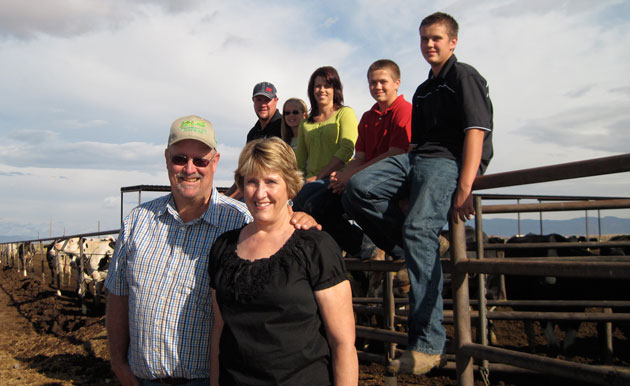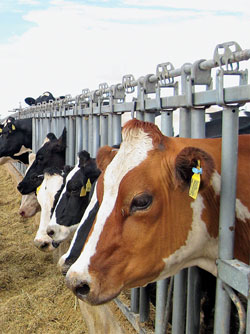
Ron and Linda Jones, front, farm with their family, left to right on fence: son Dale, granddaughter Brittney, daughter-in-law Susie, and grandsons Bradley and Brandon.
Photos by Nancy Jorgensen
New Mexico father-and-son dairymen Ron and Dale Jones began growing more of their own forage six years ago. It was a smart move and good timing, considering the current high feed prices. In fact, it’s proved to be their ace in the hole lately.
“We’re doing it out of necessity,” Ron explains, as he takes a break from cutting green chop on a September morning — something he’s done every day since April 17, starting with wheat hay, then alfalfa and corn silage. “Raising your own forage is much cheaper than buying it.”
The practice gets high marks from the Joneses’ lender, Ag New Mexico, which provides them with operating credit. “Jones Dairy is one of the higher performing operations in the region,” says Warren Russell, their relationship manager. “There’s little forage grown in New Mexico, and even less grain. The drought in the Midwest really increased the price of corn. Growing more forage helps the Joneses succeed.”
NEW MEXICO — A TOP DAIRY STATE
New Mexico ranks as the ninth largest dairy-producing state, although it ranks 36th in population. Two million people make New Mexico home. New Mexico’s cows produced an average of 24,854 pounds of milk in 2011, compared with 21,345 pounds produced by the average cow in the U.S. Sources: USDA NASS and the U.S. Census
Robert Hagevoort, an Extension specialist known as the Dairy Doc at New Mexico State University in Clovis, says area dairy farmers started growing more forage 10 years ago, and the trend is heating up.
“Many farmers now grow somewhere between 50 to 100 percent of their forage needs,” Hagevoort says. “It is one of the reasons why California dairies have relocated to other states with ample and affordable farmland, such as New Mexico and West Texas.”
Hard Work Comes With the Territory
The Joneses doubled the size of their milking herd from 1,500 cows seven years ago, when they installed a rotary milking parlor, to 3,000 cows today. Between growing forage and milking, it takes 46 employees to keep the Veguita, N.M., operation going.
Ron’s dad, D.C., now deceased, started Jones Dairy more than 50 years ago, and the family has always grown some forage on the home place. In 2006, Ron and Dale bought a farm near Estancia, which they irrigate with well water distributed via pivots.
Three years ago, they leased more land closer to home, which they furrow-irrigate using water that flows through canals from the Rio Grande River. “Furrow is more labor intensive, but it’s more cost effective because it takes less electricity,” Ron says. New Mexico experienced drought in 2011 and, to a lesser degree, in 2012. “We’re short on water here along the Rio Grande. The rains came just in time this summer.”
In all, the Joneses farm about 3,000 acres. When asked if farmland is affordable in their area, Dale and Ron answer with a resounding “No!” Land near Estancia is more reasonable; that’s why they were willing to farm it, even though it’s 50 miles northeast of home.
Rio Grande Valley property sells at higher prices than most farmers are willing to pay, partly because it’s green and beautiful. That’s why the Joneses lease their new land in the valley. “You can’t make buying land pay here,” Ron explains.
TIPS FOR SUCCEEDING IN DAIRYING TODAY
Ron Jones specializes in forage production, while his son, Dale, focuses on milk production. “Dale gets more milk per cow than I ever did,” Ron admits. Raising more forage helps, but Ron credits their increased production to the rotary milking system, higher pregnancy rates, and improved artificial insemination, nutrition and veterinary practices. Following are their detailed secrets for success.
Upgrade to a rotary system. The rotary milks 56 cows at a time, around the clock, saving time and labor. It was tough to train the cows to step on and back out of the rotary at first, but now they enjoy it. Ron and his wife, Linda, traveled to Australia to see the equipment before buying it. They continue to tweak efficiency, recently doubling the number of wheels that rotate the platform.
Use new technology. The rotary system reads each cow’s tag as she is milked and records production. Software also tracks each cow’s health records.
Get bigger. This applied in their case, at least. New Mexico’s dairies tend to be large, with almost half milking 1,000 cows or more. The average U.S. dairy farm milks just 179 cows. “You have to be a decent size to make it work here,” Ron explains. “There’s no pasture or grain, and you’ve got to maximize your barn to pay the bills.”
Focus on genetics. Big Holsteins produce more milk, and some of the Joneses’ cows pump out 2,000 pounds a month. The herd produces an average of 78 pounds, or about nine gallons, per cow per day.
Pick a good location. Jones Dairy is situated 50 miles south of Albuquerque, New Mexico’s largest city. “The farther you are from the processing plant, the more freight you pay,” Dale says. “But if you’re too close to the city, you pay more for land.” New Mexico also offers favorable weather for dairy cows.
Sell to a good co-op processor. The Joneses sell their milk to Dairy Farmers of America (DFA), which markets milk under the Elsie brand. With 16,000 members, DFA is the nation’s largest dairy processing co-op.
Work with a dedicated lender. Until a few years ago, the Joneses borrowed from a local bank where Ron’s dad served on the board. But the Jones operation grew, and another bank bought out the lender. Dale met Warren Russell at a dairy event, and the Joneses now borrow from Ag New Mexico. “Working with a lender who understands our business saves us time,” Ron says. “You can’t be in this business without a good banker behind you.”
Forward contract. Normally, Ron buys grain on the futures market so he can plan ahead on his costs. “But these days, I keep hoping the price will go down, and my contracts are about running out,” he says.
Get involved. Dale serves on the boards of Dairy Max, a regional marketing and promotional council, and Dairy Producers of New Mexico, which works toward favorable state legislation and industry regulation.
Thinking Smarter to Outlast the Drought
In addition to growing some of their forage, the Joneses purchase a large amount of their hay and all of their grain. Last year, the drought made hay scarce. Ron traveled as far as Colorado seeking alfalfa, which sold at an all-time high of $310 a ton. This summer, the alfalfa price dropped to $270 — still high, historically — and corn hit a record $8 a bushel.
“We’re one of the few dairies in New Mexico to feed green chop all summer,” Ron says. He planted a large acreage of corn last spring, thinking he’'d harvest some grain. “But when it got down to it, we fed most of it as silage,” he reports. “We sold some silage to buy grain.”

A red and white Holstein stands out from the herd at Jones Dairy, where average daily milk production is 78 pounds per cow.
Considering the current high grain prices, the family’s animal nutritionist suggested cutting back on the amount of grain they feed. Ron disagrees. “Some who’ve cut back on grain aren’t producing as much milk. I want to keep production where it is now. I’d rather cull cows that aren’t productive.”
The Joneses owned some farming equipment when they bought the Estancia farm, and added newer, bigger machinery as they could afford it. Offsetting that expense, they spend less on fertilizer than farmers without dairy cows, because they can apply manure as a soil nutrient.
As for the future, Dale says, “I used to want to keep expanding. With today’s high input costs, I’m not so sure. But we’re better positioned now that we’re more diversified.”
-Nancy Jorgensen
DISTRICT’S DAIRIES BY THE NUMBERS
| ALABAMA | LOUISIANA | MISSISSIPPI | NEW MEXICO | TEXAS | |
| Total number of farms * | 47,500 | 29,000 | 42,400 | 23,000 | 245,000 |
| Number of dairy farms ** | 157 | 298 | 177 | 272 | 1,293 |
| Number of milk cows * | 11,000 | 18,000 | 14,000 | 329,000 | 431,000 |
| Total value of all ag products sold ** | $4.4 billion | $2.6 billion | $4.9 billion | $2.2 billion | $21.0 billion |
| Value of sales of milk and other dairy products from cows ** | $38 million | $72 million | $63 million | $1.0 billion | $1.3 billion |
The number of dairy farms in the second line reflects all farms, even those with just one cow. As of July 2012, farms licensed to sell Class A milk in Texas totaled 483, and in New Mexico, 149. Data wasn’t available for other states in this region.
*USDA NASS 2011 State Agriculture Overview **USDA 2007 Census of Agriculture